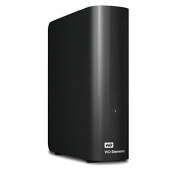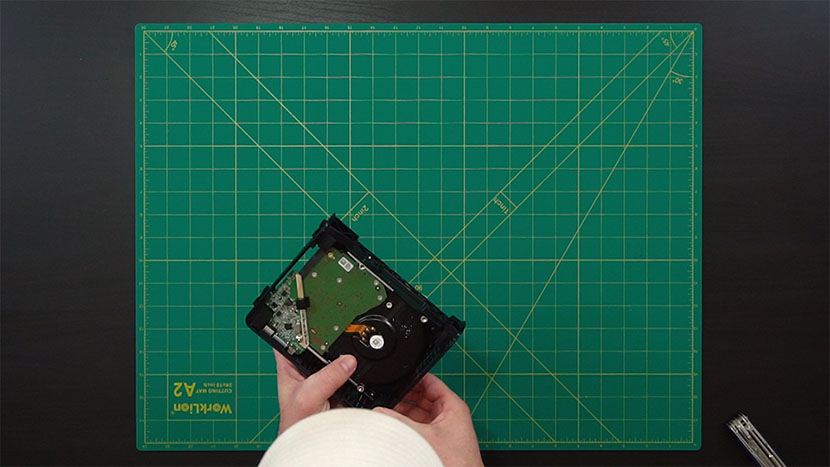As a DIY NAS builder, there are no two ways around this fact: storage winds up eating up the biggest chunk of your budget. While the other components can be pricey too, the hard drives generally have accounted for 65-80% of the cost in nearly every one of my DIY NAS builds. I don’t generally wind up getting to practice what I preach in my own builds, but I try and encourage people to be methodical and look for special deals in buying their storage as a good way to save money.
However, lurking out there is a great tactic that I’ve never–until now–leveraged in either my own DIY NAS build or any of the ones that I have written about in my blog!

Shucking External Hard Drives
For some completely unknown–at least to me–reason, external hard drives are cheaper than their internal counterparts. Logically, it doesn’t make a whole lot of sense, as there’s more hardware (the enclosure) and cost to the manufacturer in creating an external hard drive. About the best guess I’ve seen to explain this is the fact that oftentimes, the external hard drives have shorter warranty periods than that of an internal drive. In the example below, a Western Digital external 6TB hard disk drive is 33% cheaper than something comparable as an internal drive!
- WD Blue 6TB Internal Hard Drive (WD60EZAZ): $134.00
- WD 6TB Elements Desktop External Hard Drive (WDBWLG0060HBK-NESN) $89.99
So what does shucking an external hard drive mean? Effectively, it means removing the hard drive from its USB enclosure and then using it inside your machine–just like you would an internal hard drive.
You might be asking yourself, “What’s the catch?” Here are a couple reasons you might not want to shuck an external drive for your own DIY NAS build–or any other PC build either.
- You're likely voiding your warranty: Once you crack open any manufacturer’s seal, that shorter warranty period I mentioned previously is very likely to have come to an end. If that hard drive winds up dying because it’s defective, you’re probably going to have a hard time getting the manufacturer to replace it.
- It may not even be possible: For all you know, when you crack open the case, you might find that the draconian manufacturer might have completely removed the SATA connector from the back of the hard drive and soldered it to the USB circuitry, making it next to impossible for you to use in your DIY NAS.
- It could look and sound easier than it really is: If I had a dollar for every time I watched a YouTube clip of someone doing something and said, “Hey, that looks simple!” and then four hours later I’m fed up and muttering profanities under my breath, I’d be a wealthier dude.
- You never know what you're going to get: Often-times you’ll hear people share that they got a hard drive from a particular coveted product line ideally suited for DIY NAS duty to the delight and envy of even the snobbiest DIY NAS aficionados, but there’s nothing guaranteeing that you’ll have the same experience. You may just wind up cracking open the case and finding that it wasn’t the primo hard drive you’d read about elsewhere.
All of the above are risks. Assuming that all of the above are true, there are a few scenarios up there where you could find yourself up the proverbial creek without a paddle. There’s a risk-reward calculation in here that needs to be done. If the reward is great enough and the risks can be mitigated, I think it’s something that you should strongly consider.
Your best bit of risk mitigation is probably sitting right at your fingertips: open up Google and type in the external drive’s model number and “shuck” into the search engine and look over the first page or so of results.
Why the shuck haven’t you been doing this all along, Brian?
So why haven’t I been shucking external hard drives all along? I guess above all else, I have striven for simplicity and avoided risk in the creation of my DIY NAS builds. I’ve placed a premium in my builds, hoping to make them seem simple and straightforward. Shucking external drives was an added bit of complexity that I typically avoided.
Up until researching and writing this blog, my own risk-reward calculation said that the money saved on shucked drives was not yet significant enough to offset the risks and effort. However, the price differences between the external drives and their internal counterparts have reached the point to cause me to rethink my position on shucked drives!
Brian shucks an External 8TB Hard Drive
I’ve written about this before, but I’ve been in a long process of replacing all of my 4TB hard drives in my own personal NAS with 8TB hard drives. For the longest time, I’ve had six 8TB hard drives in my NAS and one 4TB hard drive. Because of the drives’ quantities, size, and my own raidz2 (two redundant drives) configuration, I’ve been stuck sitting at 20TB of actual usable storage and wasting 4TB of space on each of those 8TB hard drives.
 I finally decided that I would upgrade to that seventh 8TB hard disk drive, and I’ve been keeping an eye on prices, waiting for a good deal to shuck my first external hard drive. Because I’m pretty risk-averse, I wound up doing quite a bit of of research into which enclosures were easiest to shuck and what kinds of hard drives people had found them in. I wound up going out and reading quite a few forum posts, watching a few YouTube videos, and reading quite a few posts on /r/DataHoarder before deciding to buy the Western Digital Essentials 8TB.
I finally decided that I would upgrade to that seventh 8TB hard disk drive, and I’ve been keeping an eye on prices, waiting for a good deal to shuck my first external hard drive. Because I’m pretty risk-averse, I wound up doing quite a bit of of research into which enclosures were easiest to shuck and what kinds of hard drives people had found them in. I wound up going out and reading quite a few forum posts, watching a few YouTube videos, and reading quite a few posts on /r/DataHoarder before deciding to buy the Western Digital Essentials 8TB.
Based on my research, the Western Digital Essentials 8TB was likely to have a white-label version that was either the same or very similar to the Western Digital Red 8TB HDD. And based on the Western Digital data sheets for their various hard drive product lines (ie: Blue, Purple, Red, etc…), I wasn’t too concerned if the hard drive that I found inside the enclosure wound up being a bit different than what I’d learned from my research.
Conclusion
I’m a bit less conclusive in my YouTube video about shucking drives, but I now think shucking external hard drives is a no-brainer for DIY NAS builders! As of the writing of this blog, the Western Digital Red 8TB hard drive is over $80 more expensive than the Western Digital 8TB Elements Desktop Hard Drive. At that price, it’s 38 percent cheaper! I wound up picking an external hard drive that has a reputation for being easy to shuck, but it could get considerably more difficult and still wind up being an excellent value in my opinion.
What do you guys think? Does my experience have you interested in shucking drives for your own DIY NAS? Or, if you already used shucked drives in your DIY NAS, what has your experience been like? Have the shorter, and likely voided, warranties come back to bite you? Please let me know how things worked out for you in the comments below!

